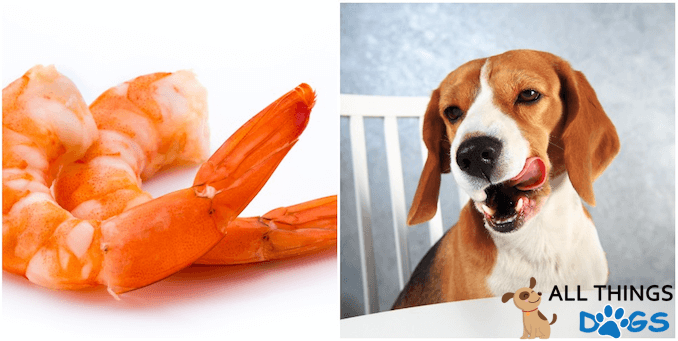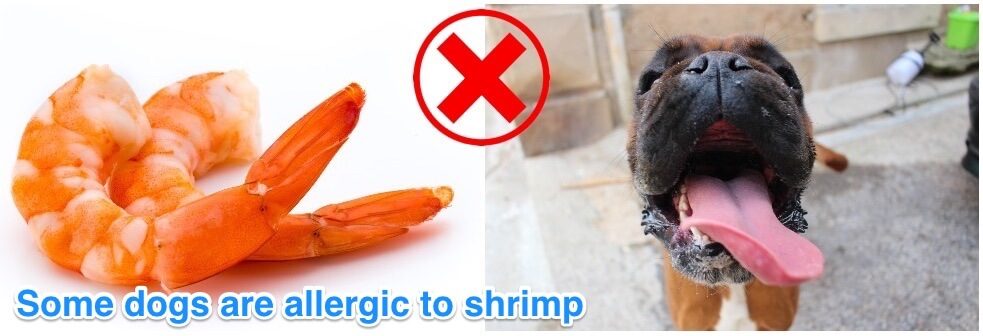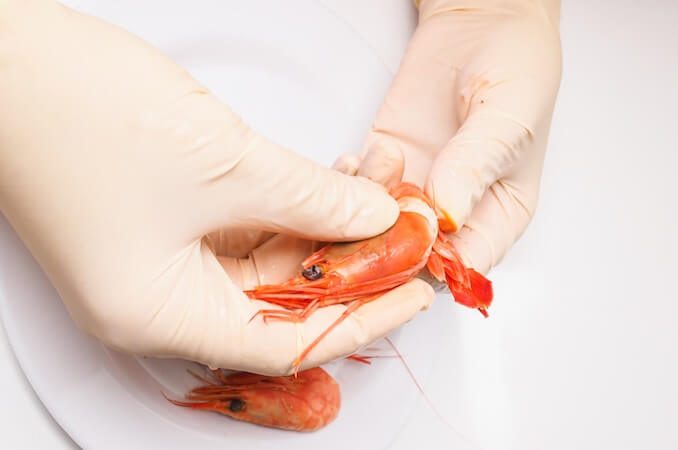
Those puppy dog eyes are looking up at you again; you know your faithful friend wants some of that shrimp you are eating.
As much as we know we should not give large amounts of table scraps to our dogs, we often wonder whether just a few will be OK?
The bigger question is actually can dogs eat shrimp?
You’ll be pleased to know, it is perfectly safe to feed your dog shrimp in moderation and only when cooked.
In this article we will answer some of those burning questions about feeding these delicious sea foods to your dog.
TABLE OF CONTENTS
Is Shrimp Good for Dogs?

As we discussed earlier, it is perfectly safe for Fido in smaller amounts and when cooked properly.
Shrimp is a crustacean and often confused with prawns; they are very similar in appearance and their names are commonly used interchangeably.
You would notice more prawns on the menu over in the UK, whereas we call them shrimp here in the states.
It is generally classed as a healthy option due to its nutritional value dog both humans and dogs alike. But how much goodness is locked into those crustaceans?!
| Calories | 84 |
| Carbohydrates | 0 |
| Total Fat | 0.9 g |
| Omega 3 | 295 mg |
| Omega 6 | 17.9mg |
| Protein | 17.8 g |
| Vitamin A | 191 IU |
| Vitamin C | 1.9 mg |
| Vitamin E | 1.2 mg |
| Niacin | 2.2 mg |
| Vitamin B6 | 0.1 mg |
| Folate | 3.4 mcg |
| Vitamin B12 | 1.3 mcg |
| Choline | 68.8 mg |
| Cholesterol | 166 mcg |
| Calcium | 33.2 mg |
| Iron | 2.6 mg |
| Magnesium | 28.9 mg |
| Phosphorus | 116 mg |
| Potassium | 155 mg |
| Sodium | 190 mg |
| Zinc | 1.3 mg |
| Copper | 0.2 mg |
| Selenium | 33.7 mcg |
As we can see, it is low in fat, calories and carbohydrates but, shrimp is high in protein, vitamin B12, niacin and phosphorus.
We can compare this against a dog’s recommended protein and fat intake.
(30 pound dog) | (3oz portion) |
|
| Protein | 35.6 grams | 17.8 grams |
| Fat | 21.76 grams | 0.9 grams |
You may notice that shrimp is also high in cholesterol. Surely that’s a bad thing?
First of all, there are two types of cholesterol:
- Low-density Lipoprotein (LDL) – generally known as the “bad”
- High-density Lipoprotein (HDL) – the “good” cholesterol
A study was carried out by Rockefella University to research the impact of shrimp on overall cholesterol levels in humans. A diet high of this delicious food did raise cholesterol, as it raised both LDL and HDL cholesterol.
However, the high levels of HDL transport the LDL in the body back to the liver to be broken down and removed; high levels of HDL is actually associated with a lower risk of heart disease.
Does all of that mean it’s a good thing for dogs to be eating?
Health Benefits of Your Dog Eating Shrimp

As we’ve mentioned, this delicious food is high in protein, vitamin B12, niacin and phosphorus. These bring a whole range of health benefits to your pooch.
Why is Protein good for a dog?
We can think of protein as the building blocks of a dog’s body. It is an essential nutrient responsible for building and repairing muscle and maintaining and repairing organs.
It is also a source of energy.
As we’ve seen, shrimp is high in protein.
The daily protein requirement for a fully grown dog is 1.20 grams per pound of body weight.
So if you have a dog weighing in at 20 lbs, your dog should be eating 23.58g of protein per day. 3 ounces of shrimp would provide 75% of their recommended daily requirement; that’s a lot!
Other Healthy Vitamins and Minerals…
- Vitamin B12 is a nutrient which keeps nerve and blood cells in the body healthy. It also has a vital role in creating DNA. A lack of B12 causes weakness, fatigue, loss of appetite and weight loss. The current guideline for recommended daily intake of B12 for dogs is 0.022mg per kg of weight, based on a dry kibble diet.
- Niacin, also known as vitamin B3, is a vital nutrient required in every part of your dog’s body. Niacin has a range of functions including: converting food to energy, making and repairing DNA and acting as an anti-oxidant.
- Phosphorus, after Calcium is the second most abundant mineral found in your dog’s body. It is crucial to bone and teeth formation and health. Working in sync with the B vitamins, it contributes to kidney function, nerve signaling and also maintaining a normal heartbeat. Low levels of phosphorus will cause rickets – yes dogs can have rickets too!
- As you may have noticed, shrimp is also high in Omega 3 fatty acids. Omega 3 fatty acids are vital components in cell membranes; they also contribute to regulating blood pressure and play a part in inflammatory responses in your dog’s body.
All sounds great so far, but:
Dogs Can Be Allergic To Shrimp

Unfortunately, there doesn’t appear to be any predilection of any breed, size, age or weight of dog to have food allergies.
The most common food allergies noted for dogs are:
- Milk
- Bread
- Eggs
- Cereal
- Soy
- Corn
- Chicken
Dogs being allergic to fish is less common, but it does still occur.
Symptoms that your dog is allergic to a specific food are:
- Sickness
- Diarrhea
- Scratching
- Hot spots
- Ear infections
- Excessive flatulence
In severe cases, dogs may suffer an anaphylactic shock. This results in red skin, swelling, hives, a swollen face or muzzle, salivating or drooling, vomiting and diarrhea. Anaphylaxis can be fatal so immediate treatment from a veterinarian is crucial.
Top-Tip
Introduce any new food to your dog slowly, in small amounts. Watch for any new or changes in behavior or health.
Is Shrimp Bad for Dogs?
We know that shrimp is perfectly fine for dogs to eat, but it has to be in moderation. One or two here and there will be perfectly fine as treats.
If you plan on giving him a few more, consider how they fit in with his daily food allowance and daily nutrient requirements; especially protein.
You may need to alter his normal diet to accommodate for the shrimp.
The important thing is that you only feed your dog shrimp in moderation. If you are thinking about feeding it as a larger part of their regular diet, speak with your veterinarian or a canine dietician first.
Which Parts Can a Dog Eat?
Can a dog eat shrimps?
Yes – as long as they are cooked and you have removed their shells!
Can dogs eat shrimp tails?
No. For humans, some restaurants keep the tails on their cooked shrimp; this is actually just to give you a handle to eat the shrimp. Your dog doesn’t have thumbs – they really don’t need a handle to help them eat. Take the tail off!
Can dogs eat cooked shrimp tails?
No. The tails should be removed before you feed them to your pooch. Swallowed, they could cause an obstruction in your dog’s airway. Their sharp edges would also cause irritation in his upper gastrointestinal tract.
Can dogs eat shrimp shells?
Like the tail, the shell should be removed from the shrimp before feeding to your pup. When you have removed the shell, it is easier to remove the vein that runs along the shrimp’s back. This vein is actually the digestive tract of the shrimp and will contain what he has recently eaten, most likely some grit too.
Can my dog eat cooked prawns?
Like shrimp, cooked prawns are perfectly safe for your dog, in moderation.
Is Crab safe to feed your dog?
Cooked crab, in moderation is fine for a tasty treat for your pup. There are more reports of allergies to crab due to their high iodine content so as with all foods, introduce slowly and watch for any reactions or changes in health.
Preparing Shrimp for a Dog to Eat

Raw shrimp, like most seafood, contains a range of pathogens which are associated with a range of diseases.
For this reason, we would always advise cooking shrimp before feeding it to your dog.
You can buy fresh or previously prepared that have been stripped and cleaned – they would have had their heads, tails and shells removed already.
Steaming is the healthiest option for your dog:
- Bring a large pot of water to the boiler
- Pop the shrimp into a steaming basket over the top of the pot
- Steam shrimp until it is pink and slightly opaque. If it goes bright white, you have overcooked it.
If you have bought fresh shrimp that haven’t been cleaned, remove the shells and tails before feeding to your pooch.
Introduce one or two to your dog and see how he copes, watch for any vomiting or diarrhea or signs of intolerance or allergy.
Stop feeding immediately if you notice any of this.
Summary
Next time he’s giving you those puppy dog eyes, you’ll know, yes dogs can eat shrimp.
It is perfectly safe for your pup, if cooked and served in moderation.
It is high in protein, vitamin B12, niacin, phosphorus and Omega 3 fatty acids which bring a whole range of health benefits to your pooch.
Steam and remove the heads, tails and shells before feeding.
Watch for any signs that he’s not tolerating it, or may even be allergic to it.
Remember anaphylaxis requires immediate veterinarian attention.
How does your pooch like shrimp? Do you have any alternative recipes which they love? Let us know in the comments below.




Be the first to comment